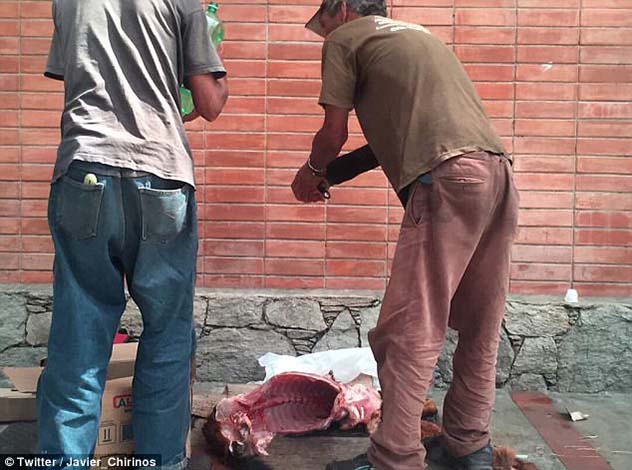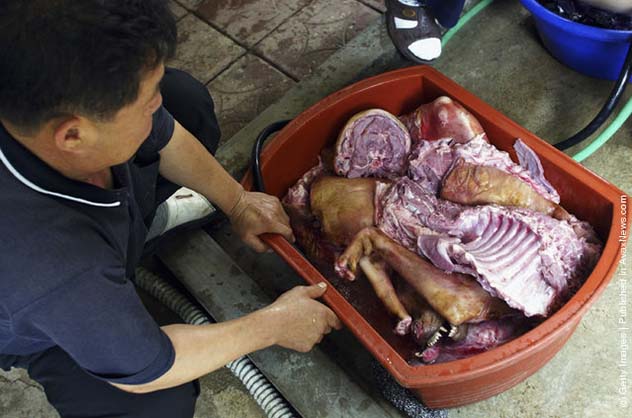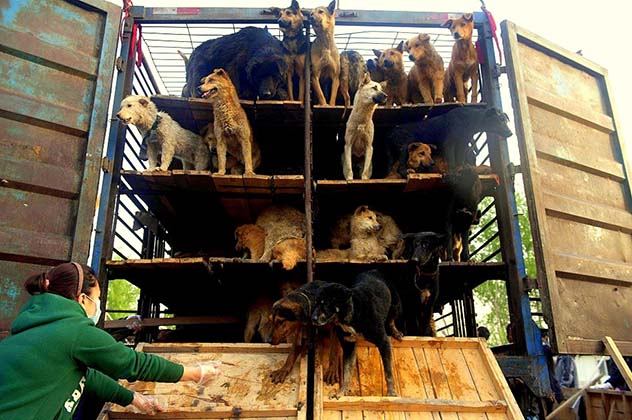 Movies and TV
Movies and TV  Movies and TV
Movies and TV  History
History 10 Things You Never Knew About Presidential First Ladies
 Movies and TV
Movies and TV 10 Zombie Movies That Will Actually Terrify You
 Humans
Humans 10 Times Scientists Were Absolutely Sure… and Absolutely Wrong
 Our World
Our World 10 Pivotal Moments for Life on Earth
 Movies and TV
Movies and TV 10 Most Realistic Medical TV Shows of All Time
 Creepy
Creepy 10 Eerie & Mysterious Ghosts of the Pacific Coast
 Weird Stuff
Weird Stuff 10 Typos That Accidentally Changed History
 History
History 10 Times Trickery Won Battles
 Technology
Technology 10 Awesome Upgrades to Common Household Items
 Movies and TV
Movies and TV 10 Movie Flops That Found Their Way to Cult Classic Status
 History
History 10 Things You Never Knew About Presidential First Ladies
 Movies and TV
Movies and TV 10 Zombie Movies That Will Actually Terrify You
Who's Behind Listverse?

Jamie Frater
Head Editor
Jamie founded Listverse due to an insatiable desire to share fascinating, obscure, and bizarre facts. He has been a guest speaker on numerous national radio and television stations and is a five time published author.
More About Us Humans
Humans 10 Times Scientists Were Absolutely Sure… and Absolutely Wrong
 Our World
Our World 10 Pivotal Moments for Life on Earth
 Movies and TV
Movies and TV 10 Most Realistic Medical TV Shows of All Time
 Creepy
Creepy 10 Eerie & Mysterious Ghosts of the Pacific Coast
 Weird Stuff
Weird Stuff 10 Typos That Accidentally Changed History
 History
History 10 Times Trickery Won Battles
 Technology
Technology 10 Awesome Upgrades to Common Household Items
Top 10 Stomach-Churning Facts About People Eating Dogs
What may be considered a delicacy in one country may cause an individual to lose their appetite in another. Such is the case with the consumption of dog meat; although completely unheard of in the United States, is surprisingly quite common in various nations throughout the world. The following ten scrutinizes this practice which waivers between disgusting and delicious while examining historical facts in addition to morbid and grotesque present-day cases certain to make one’s stomach turn.
SEE ALSO: 10 Lies About Dogs We All Believe
10 A Fracture In Faith

Like many cultures around the world, dog meat in Japan is viewed as a major taboo. Interestingly enough, that was not the case prior to the 6th century. When Buddhism arrived from Korea, the belief was instilled that meat-eaters ran the risk of consuming their reincarnated ancestors. Nevertheless, it would not be until 675 A.D., that the first official decree banning the consumption of meat—including the dog—took place under the orders of Emperor Tenmu. The practice would remain until 1868 when Emperor Meiji began a movement to end two centuries of ancient dietary interdictions.
As expected, the transition did not sit well with devout Buddhists who considered the consumption of dog—as well as all four-legged animals—a sin. Viewing the change as an existential spiritual crisis, an assembly of incensed Japanese Buddhist monks stormed the Imperial Palace on February 18, 1872, seeking the Emperor to answer for the country’s indefensible sin. In the end, their efforts would be in vain with half of the monks slaughtered like dogs by the swords of the Imperial Army. In spite of the continual conviction that eating meat was “destroying the soul of the Japanese people,” the Emperor’s wishes prevailed. These days, the Japanese consume as much meat as they do sushi – minus, of course, dog—which never gained its prominence as it once had 1,200 years ago.
9 On The Brink Of Extinction

The Xoloitzcuintli (Xolo for short) or ‘Mexican Hairless Dog’ is one of the world’s oldest breeds dating back over 3,000 years. In pre-Hispanic Mexico, the Mayans believed that the dogs had the power to connect one’s soul to the afterlife. Specifically, the dog would guide the departed through the unknown darkness of the underworld until reaching the gates of heaven. Thus, with such belief, the Mayans would sacrifice the Xolo and bury them in the grave of their recently departed master for the beginning of their journey to eternal life.
The Aztecs’ spiritual belief differed in that they would sacrifice Xolo puppies as an offering to the rain God or ‘Tlaloc.’ As the years passed, the sacrificial methods by the Aztecs changed. They felt it necessary that the puppies must be eaten in a ritual feast. Given the small stature of the Xolo, however, the Aztecs continuously fed the dogs in order to fatten them up as much as possible prior to the ritual; thus, the fatter the dog, the more meat and ultimately greater spiritual gain. As centuries passed and rituals persisted, the unusual breed was on the brink of extinction.
By the late 1950s, only a handful remained to catch the attention of British Military attaché in Mexico City, Norman Pelham Wright. Having become fascinated with the animal, he and several acquaintances set out in remote villages to find thriving breeding pairs to ensure their survival. The action in which they took became known as the “Xolo Expedition of 1954.” Two years later, the Xolo had become recognized in its native land and in time was designated the “Official Dog of Mexico.”
8 Russian Roulette

Although repulsive, those who truly take pleasure in eating dog run the risk of major human health concerns. Take, for example, every year 5 million dogs are eaten in Vietnam. With that said, in 2007, approximately 30 percent of deaths were attributed to the consumption of dog meat contaminated with rabies. The following year the nation reported that 20 percent of dogs in slaughterhouses in Hoai Duc were found to have the virus, yet the insatiable appetite for canines continues to thrive. While the statistics are unappetizing, the Center for Disease Control documented less than 20 people to have ever survived after contracting the fatal illness.
In the Philippines, 300 people die from rabies due to the grotesque meat each year including workers handling and slaughtering the animals. A major reason for such outbreaks is the fact that the Philippines National Meat Inspection Commission does not examine dog meat, according to the regional director himself—as if he took pride in his admission. Aside from rabies are various other infections and diseases one can contract such as salmonella, E. coli, anthrax, hepatitis, bacteria associated with Cholera and Ebola. To make matters worse, caged dogs in disease-ridden conditions are given large quantities of antibiotics leading to the rise of superbugs. This—according to the Review on Antimicrobial Resistance—has created an enormous threat to global human health in that drug-resistant infections have the potential to kill 10 million people a year by 2050.
7 Chaos In The Streets

Sadly, the world has bear witness to the once rich and promising country of Venezuela collapse under political and economic turmoil. With the nation spiraling deeper into mayhem, the powerless citizens desperate to overthrow socialist President Maduro are subjected to mounting crime and violent riots. Meanwhile, there is the unremitting shortage of medicine, toiletries, and food, basic essentials necessary to survive.
The situation had become so dire that by 2016 the average Venezuelan had unintentionally lost an average of 19 pounds in the twelve-month span. By 2017, an estimated 15 percent of citizens – including young children—had taken to industrial garbage dumps and trash cans seeking any remnant of food waste. That same year, zoo animals began to disappear, evidently stolen and butchered by the starving local residents desperate to stay alive. According to zookeepers, the most desired targets were tapirs, peccaries, and buffalo. The extreme measures to supplement starvation due to the chronic food shortage have not only been witnessed in zoos but on public streets in broad daylight, as well.
These days, it has become increasingly common for citizens to chase pigeons in city plazas in addition to hunting dogs unfortunate enough to be captured roaming the streets. The tremendous actions to avoid famine have even caused locals to disregard the threat of an arrest by police. In one instance, photos published in newspapers throughout the country showmen butchering a dog on the street of Caracas. Following the canines brutal and excruciating dismemberment, the dog meat was divided and prepared for that day’s sole meal. To date, chaos continues to riddle the nation as the canine population continues to dwindle down.
6 A City Divided

In spite of international criticism compounded by the growing number of enraged local activists, every year in southern China more than 10,000 dogs are slaughtered in what is known as the annual dog meat festival. The grotesque 10-day event that “celebrates” the summer solstice stands as the epitome of torture where dogs, many of which are stolen pets, are crammed into tiny cages in the market square prior to their unbearable demise.
Those that are not already cooked and hanged on display are snared around the neck with metal hooks and then either bludgeoned, boiled or stabbed in the neck or groin in order to “bleed out.” More often than not this inhumane form of butchery occurs in public viewing for all to see including other dogs awaiting their dreadful fate. In fact, those – either companions or strays—that witness multiple deaths ahead of their own are privy to the torture causing panic to spread among the countless caged.
Nonetheless, residents of the southern city of Yulin wholeheartedly defend the celebratory practice of buying, selling and eating man’s best friend. Dog lovers, on the other hand, arrive every year to confront those joyfully partaking in the festivities with pleas of mercy or exasperated reprimands. Meanwhile, animal rights activists have at times gone a step further by either intercepting truckloads of canines or raiding slaughterhouses in an effort to limit the number killed. Through the years, the number of activists declines due to police intervention whose sole efforts are mere to “maintain stability” throughout the tense and divided city.
5 Vagueness

Given what we have seen in terms of the brutality in which these animals have suffered in their last moments, one must question the legality behind it all. Due to activists constantly crying foul, their voices were finally heard in South Korea leading to the nation adopting its first Animal Protection Act in May 1991. This law was subsequently revised in 2007 given the vagueness of the original, though the current amended law still lacks clarity with language that is indeterminate. One must note that the main controversy surrounding the killing of dogs has been centered not on the consumption of the meat, but the methods commonly used such as strangulation, electrocution, bludgeoning, stabbing, boiling, etc. With that said, the act does not explicitly create an absolute ban on the slaughter of dogs for food; however, it does declare that the animals must not be killed “in a cruel way such as hanging.”
In addition, the bill forbids the killing of dogs in open areas “such as on the street or in front of other animals of the same kind.” Furthermore, the bill states that a dog must not be killed “without rationale cause” but in no way offers a clearer insight leaving many to be their own judge on the matter. Consequently, the glaring hole in the APA leaves one in the dark allowing a meat vendor to interpret the law as they see fit casting uncertainty on the effectiveness of the act. It seems as if there has been no drop in the slaughter of the animals and behind closed doors, one can only imagine if people will truly adhere to the bill, in a sense rendering the Act useless.
4 To Hell and Back

We’ve seen the lengths to which people will go in order to survive and for early explorers, their journey would be to hell and back. Embarking on the boundaries of the Antarctic in the early 20th century, those who dared to make the expedition was faced with frostbite, malnutrition, scurvy and indubitably a shortage of food. This resulted in scores of sled dogs being used as a source of nutrition as opposed to being utilized for transportation. Sir Douglas Mawson—who mounted a three-man Australasian Antarctic Expedition, Aurora, from 1911 to 1913 – wrote; “In an enterprise where human life is always at stake, it is only fair to put forward the consideration that the dogs represent a reserve of food in cases of extreme emergency.”
Just 320 miles into their journey, the majority of the food was lost after one of the men fell into a crevasse along with their goods. Desperate and starving, Mawson made the decision to kill the huskies unknowing what would befall him. As we have previously seen, there is a great risk that comes with dog meat in terms of disease one can contract. For Mawson and his fellow explorer, Xavier Mertz, the two fell victim to vitamin A poisoning from eating dog liver. What followed was fissuring of the skin, wasting, and dementia, ultimately claiming Mertz’s life. Miraculously, Mawson managed to continue his journey eventually making it to his base alone, nearly 100 miles away. What resulted from his death-defying exploration “contributed more geographical knowledge of Antarctica than any other explorer of the Heroic Age.”
3 Medicinal And Culinary Lard

Dating back more than 2,000 years, animals have been used for human medicinal purposes. In spite of how irrational these ‘remedies’ maybe (goat hooves for baldness, ground horse for epilepsy) some have stood the test of time especially in various parts of Southern Europe. Of the most prominent integration of domestic animals are dogs and interestingly enough, continue to be slaughtered for bizarre concoctions in rural regions of Poland.
In 2009, police arrested a woman at her farm in Czestochowa, Poland after it was discovered that she had been selling jars of dog lard as a health supplement. Further investigation of the premises uncovered 28 well-fed dogs, ranging from puppies to St. Bernards, chained in cages awaiting their death. The unidentified woman had been intentionally fattening up the dogs to such an extent that some “were overfed to the point of no longer being able to walk.” Upon her arrest, the woman stressed the health benefits of the lard stating that she even added a spoonful to her daughter’s meals.
A similar case occurred in Wieliczka where a man was detained for stealing and slaughtering local dogs to make smalec, a Polish lard delicacy. It came to light following his arrest that the 70-year-old man had been kidnapping pets for the past 50 years. Once captured, he would butcher the animal and then render down the fat before selling it to his neighbors, many of whom had their pet mysteriously disappear. In the end, the Krakow District Court found the man not guilty despite his admission given that the dogs were “slaughtered in a humanitarian way for culinary purposes.”
2 Karma

Whether it is karma or merely a case of bad luck, a dog meat vendor in China got a taste of his own medicine (or toxin) in June of 2013. While demonstrating to his meat-selling crew how to use a crossbow in order to kill dogs, the reckless vendor accidentally fired a toxic dart into his own leg. The poison proved to be quite potent and effective given that he expired on his way to the hospital. Following the fatal mishap, the remaining members of the gang – who were responsible for killing and butchering more than 1,000 dogs – were arrested subsequent to the demise of their uncoordinated and departed leader.
The downfall of yet another crossbow-wielding chap occurred in the Jiangsu province of China in 2018. Unlike the previous rascal, his fate was not due to clumsiness but an irate dog owner thirsty for revenge. Upon discovering his pet lying in the street crying and paralyzed, the owner observed the heartless canine killer fleeing the scene on a scooter. Within a blink of an eye, the furious man gave chase in his vehicle before catching up and crashing the ruthless thug through a brick wall, instantly turning him into roadkill. The man was later arrested and charged with manslaughter.
1 Unhinged and Hungry

A farmer in South Korea apparently had enough of the incessant barking from his neighbor’s dog that he decided to take matters into his own hands. Armed with a rock, the 62-year-old did what any annoyed senior would do – he bashed the Welsh corgi’s head in. In order to ensure the peaceful silence, the unnamed man proceeded to strangle the dog before turning the animal into a tasteful dinner. Once cooked to perfection, he invited the dog-owning family – who had been frantically searching for their beloved pet – to join him for the meal. Once the cuisine filled their unsuspecting bellies, the unhinged farmer-chef confessed to the ingredients. As one could imagine, the family was quite offended and alerted authorities.
As disturbing as that may be, it pales in comparison to our next mischievous prince. While “on a bad trip” after smoking the synthetic drug “spice”, Michael Daniel of Texas, assaulted his housemates before crawling on his hands and knees, growling and chasing a concerned neighbor back into his home. Becoming breathless from all the physical activity, Daniel, 22, reached for the closest snack – his housemate’s medium-size spaniel mix. The crazed roommate then proceeded to beat and strangle the dog before chewing “hunks of flesh” from the defenseless pet. By the time officers arrived, they found Daniel sitting on the porch with “blood and fur around his mouth” along with the lifeless body of the dog lying in his lap. As expected, Daniel was promptly arrested and charged with cruelty to a non-livestock animal.
For more lists just like this, take a look at 10 Ways You Could Eat Feces Today, and 10 Disgusting Things Done to Food and Drink.








